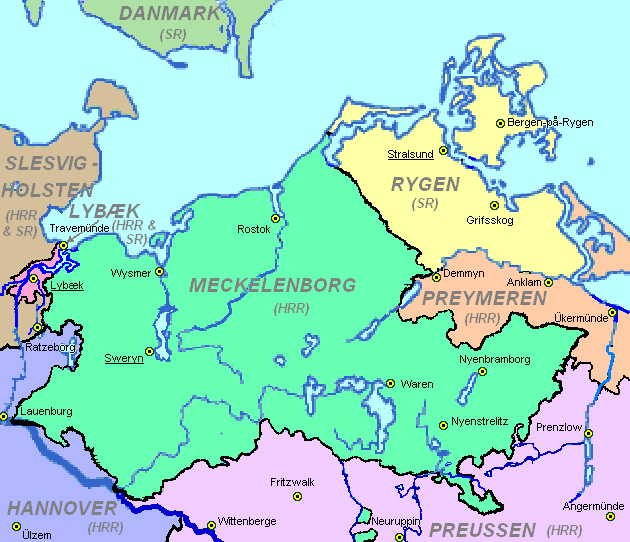Rygen
|
Rygen is Danish fief and as such part of the Scandinavian Realm (but not of the Holy Roman Empire). Rygen is a member of the Baltic League. WAY back in the beginning of the Viking Age *here*, the region we know as Mecklenburg, Brandenburg, and Pommerania was occupied by West Slavic heathen tribes called Wends - _not_ to be confused with Romance- speaking Veneds. By the beginning of the 12th century, they were eventually Christianized except for the island of Rügen and the nearby coastlines along the mainland, which remain the last stronghold of slavic heathendom in Western Europe. Mecklenburg and Brandenburg were subject to German Christianization and colonization, while Pommerania was subject to Polish Christianization and subjugation. Let's assume a similar thing *there* - the obvious difference would then be that Preimarn (as Pomerania is known *there*) would be subject to Venedic Christianization and perhaps even colonization. Eventually, Mecklenburg and Brandenburg were incorporated into the Holy Roman Empire, while Preimarn become a vassal of the Venedic Kingdom. Preimarn, however, later became fully independent in the mid-12th century as the Venedic Kingdom become preoccupied by internal struggles with the death of Duke Boleslaw II - at least that's the way it went with Poland *here*, so Jan may have this differently. The 12th century was also a time when Denmark was expanding. In the mid-12th century, Denmark was repeatedly being harassed by the heathen Wends of Rügen. The Holy Roman Emperor then assigned Denmark the task of conquering the "lands of the Wends" in 1162. In the process of carrying out this assignment, Denmark conquered the Slavic heathen principality of Rügen, to which not only the island of Rügen itself, but also the portion of the mainland across the strait, belonged. After his defeat, Prince Jaromar of Rügen accepted his land as a fief of Denmark, and monastaries were established all throughout the principality. After the conquest of Rügen, Preimarn felt threatened. It sought protection from the Holy Roman Empire. In 1181 Preimarn became an Imperial fief. This meant that the Holy Roman Empire now included a Slavic duchy. In 1184, while the Preimarnians, at the direction of the new Emperor, were conducting a crusade against Prince Jaromar of Rügen, who was now a Danish vassal, the Danes defeated them in a naval battle near Greifswald. The emperor was unable to protect and support his own vassal, because he was deeply involved in Italian politics. In 1185, Preimarn became a Danish fief, and remained one until 1227, even though the Holy Roman Empire never gave up its claim to sovereignty. At one point, Denmark excercised so much power in the region that even Mecklenburg swore fealty to Denmark, and the Danish King styled himself as the King of both the Danes and the Wends. Northeastern Germany was still called the "Land of the Wends" even though the Wends themselves were already by then a minority group. There was even a "Wendic" monetary union in the middle ages where the different states in the region shared the same currency system. Anyways, the title of "King of the Wends" continued to be used by Scandinavian kings *here* right up to the 1970s as a commemorative title. Denmark's domination of the Wendic lands changed in 1227 when allied troops from Holstein, Mecklenburg, Saxony, Lübeck, Hamburg, and Bremen finally put an end to Danish subjugation by defeating its troops on July 22, 1227, at the Battle of Bornhöved. After the Battle of Bornhöved, Preimarn managed to shake off Danish suzerainty in 1227, but instead swore fealty to the Holy Roman Empire once again. Its course was set to become a German territory. Like *here*. But unlike *here*, Denmark was allowed to keep the Principality of Rügen. The catch to all this is that territory around Rügen *there* is not called Hither Preimarn as would be expected if history was a little more analogous to *here*. Instead, it would be called Ruegen in English (or Rygen in Danish). Ruegen would also not be a part of the Holy Roman Empire. Instead, Ruegen would have had the same status as Schleswig - that is, a Danish fiefdom in personal union with the Danish King. It might also have been divided up into royal portions and ducal portions, like with Schleswig-Holstein. Anyways, just as the original slavic language in Pommerania was replaced with German in Pommerania because of its subjugation by the Holy Roman Empire, the original Wendic language of Ruegen would be replaced by Danish because of its subjugation by Denmark. I can just imagine what "Rygsk" dialect of Danish sounds like. ;) [KJ] |

|
| |||
|---|---|---|---|
| National States | |||
| Denmark | Sweden | Norway | Finland | Rygen | Samme | Schleswig-Holstein | Oldenburg | Lybæk | Faeroe Islands | Iceland | Greenland | New Sweden | New Iceland | Gadangmeland | Gebaland | Pepper Coast | Cruzan Islands | Tranquebar | Frederiksnagore | Nicobar Islands | Andaman Islands | Monland | Tenasserim | Tsingdav | |||
| Territories | |||
| North Atlantic Dependency | South Atlantic Dependency | Antarctic Dependency | |||
| Realm Capital Territory | |||
| Rikshovedstadsområde |